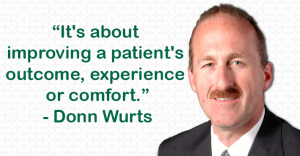Job hunting is fraught with challenges as it is, but breaking into a fiercely competitive healthcare field where knowledge requirements evolve fast can be even more difficult.
At HIMSS18 in Las Vegas, there was no shortage of opportunities to learn how to polish your resume or make connections that could lead to your next job.
Jason Bickford, President of HIMSS Chapter of Arizona who works as a Systems Engineer with Cigna, spoke at the event, outlining some job search best practices for those in attendance. He shared his extensive experience in searching for new positions and what has helped him find success in the market. Here are some key points from that session.
Persistence is Important
Looking for a position in health IT can be a time-consuming process. Finding a position that you qualify for and with a company you identify with culturally is a big challenge, so preparing yourself for a long road ahead is a good idea. According to Bickford, a candidate for a health IT job has roughly an 8.3% probability of getting a job from one application. It can take as many as 10-20 applications to get one interview and 10-15 interviews to get one job offer.
Typically, it takes 10-30 days to hear back from a potential employer and, on average, a candidate who gets hired won’t start for 12 weeks.
Bickford also advised that healthcare workers should not necessarily fear taking temporary positions in the gig economy. According to a study from Intuit, 40% of the American workforce will be independent by 2020, working as part of the growing gig economy.
“All industries are moving toward the gig economy,” Bickford said. “Many organizations are hiring for short term project-based roles. I took an opportunity for a three-month project just to stay engaged in the industry and stay relevant. It was a consulting role to help a hospital select their EHR and I loved it. You may think it’s not for you, but I would strongly recommend considering it because short term roles can turn into long term roles and I think by doing this type of work, it adds to your portfolio of experience.”
Find a Good Match
Job seekers should spend a fair amount of time exploring the employment landscape and researching different job descriptions. Job scan sites can match keywords to your resume, but you’ll want to research the company as well.
When you decide you want to apply to a company, don’t just submit a resume and leave it at that. First, make sure your social media profiles, particularly LinkedIn, are synced up with the information you are providing on your resume.
Don’t Underestimate the Importance of Social Media
Bickford explained how employers use social media to weed out candidates in some cases. For example, employers are 57% less likely to interview someone they can’t pinpoint on social media. As an article from Recruiter suggests, it’s important to have something out there, as your professional story via social media is equal to social proof of your resume. Lacking it can imply you’ve not achieved much or have conveyed an incomplete career story.
More than half of employers? have at some point decided not to hire a candidate based on what they did or didn’t see on a social media profile, according to a survey from Career Builder.
Even if you’re not on the job hunt, social media activity matters. According to the Career Builder survey, 70% of employers say they monitor current employees’ social media activity, and the same percentage say they use it to screen candidates.
“Before they even call, they’ll look at your social media,” Bickford said. “Make sure your LinkedIn matches your resume and don’t weave a web of lies. Be honest. Be transparent.”
According to the Society of Human Resource Management, 84% of employers are currently using social media as a recruitment tool. An additional 9% plan to do so in the future.
Always Be Searching
Job seekers should remain engaged in the search process constantly, be it through networking, training, professional development activities, social media promotion or seeking consultations. Each one is an opportunity to create a personal brand built on your experiences. Even a lunch with former colleagues is an opportunity. According to the U.S. Bureau of Labor Statistics, 70% of all jobs are found through networking.
“Meet with former peers and colleagues and reiterate your passion for the field and your interest in the work,” Bickford said. “They may not have a position today, but you’re putting yourself out there. Explore all opportunities through your networking and contacts.”
The Resume
Writing a resume can be a challenge. For young people, filling up a resume enough to show you have the experience for the position you want can be a process. For older professionals, competing for jobs in an industry surrounded by technology and new schools of thought can be daunting as facing ageism in the recruiting process is a possibility.
For that Bickford suggests altering your approach. Rather than feeling the need to recite every job you’ve ever had and a long list of achievements, go the other direction and simplify.
“Shorten your resume to only maybe three positions that are relevant to the job you’re applying for,” Bickford said. “Be more concise. It may not show the depth of your career history but doing so may show something like your age. Ageism is present in the recruiting process, so you may not want to show those years of history up front. It’s present, particularly for those 55 and up. It’s also concern for people who are transitioning into the field. Have different iterations of your resume, maybe don’t have dates on one, but do have them on another.”
When it comes to details on a resume, it’s best to focus on your accomplishments in a previous role rather than tasks and various responsibilities you may have had. Health IT roles are usually evolving, and it may not be easy to pin down a role with the exact same set of duties, nor are you likely to want that for your own career growth. Remember, you’re showing the employer your ability to be successful, not how well you can fulfill specific tasks.
“Don’t just treat your resume as a transactional document,” Bickford said. “Tweak it into a story of your accomplishment and tell the story of how you were involved in an achievement. I’m seeing more of that rather than just straightforward details of duties performed.”
Salary Talk
There are a number of things to consider when it comes to salary. Should you disclose up front what you want? Should you ask for what you want or what is realistic? For Bickford, the answer is to take a somewhat nuanced approach.
“What I would do is have a range in mind and share that and see if they are within the range,” Bickford said of salary considerations. “Sometimes you’ll apply for positions that are bit lower than what you want, but you just want to get in and move yourself up, maybe you feel like that company is a good fit. But even if you don’t end up taking a job, I think it’s a valuable experience to go through that process and have that dialogue, so you feel more comfortable having that conversation with other recruiters.”
Try to avoid money conversations early on. If you must answer the question of what you get paid at a current or past position in conversations about what you want to be paid, be honest about what you currently get paid, but tie everything together to include things such as bonuses, stock options, commissions and other benefits.



